It’s Friday night at 10:30 PM in Williamsburg, Brooklyn: dozens of cranky Brooklynites crowd the corners of North 7th and Driggs. They are waiting for a shuttle bus that will either take them across a crowded bridge into Manhattan or far into Brooklyn as Myrtle-Wyckoff, before leaving them to their own devices to somehow find their way home. The situation is a grim glimpse into the future of the trainless L-line neighborhoods. The long dreaded MTA shutdown is approaching and we are already feeling the affects.
In the meantime, here is an informative article on the MTA’s (evolving) plans from our friends at Greenline.
L-Train Shutdown Plan
By Lori Ann Doyon, August 1st, 2018, Greenline (with minor updates from Go Green BK on August 22nd, 2018)

Since the MTA and DOT presented their proposed L-Train shutdown mitigation plan to the community last December, they’ve been solidifying the proposals into decisions. In late June, The MTA and DOT rolled out their Alternative Services Plan to the NYC Council in an open hearing and since have been giving presentations of this plan to groups in the affected communities.
We got a big taste of the shutdown on the weekend of August 11–12. There was no L-Train service that weekend between Manhattan and either Myrtle-Wyckoff or Broadway Junction. This is to be the first of many scheduled weekend shutdowns for preparatory work on the L-Train in order to ensure the overall shutdown doesn’t exceed 15-months. The other scheduled No-L-Service Weekends are: every weekend in October; November 10–11; every weekend in February; the first three weekends in March; and April 13–14. There are no plans as of yet to test out any of the MTA’s Alternate Service Plan (ALP) options during these weekends.
Let’s get into some hot-button issues in the ALP that this side of the river’s community is pushing back on. For instance, Grand Street’s loss of westward through traffic (you can only go a block or you’ll get a ticket). The street will also lose 275 parking spots.
“We are really concerned about DOT’s plan to choke westbound traffic off of Grand street at Morgan Avenue. East/west traffic is already at a near standstill at various times during the day—this will render Metropolitan unpassable. Businesses making deliveries from industrial East Williamsburg and Maspeth will suffer from additional needless delays. Further, we are concerned about pedestrian and bike safety on the nearby side streets—this action will cause a spillover effect that will send traffic down tiny streets like Catherine to work their way around the roadblock,” said Leah Archibald, Evergreen Executive Director.
“I’m concerned about the impact this will have on Grand Street businesses,” said Erin Piscopink, Executive Director of the Grand Street BID. “Current plans call for limited access for deliveries and will create conditions that are harmful to the businesses here. I hope that DOT will work with the BID, receive feedback from the community, and revisit the Grand Street treatment.”
Another is that the Williamsburg Bridge is only to be traversed by buses, trucks and HOV 3+ in both directions between the hours of 5AM–10PM, seven days a week. This bone of contention is gnawed at from both sides: those who don’t have 2+ to commute with and those who are skeptical of how this will be enforced.
Yes, there are silver linings to the shutdown cloud. Some stations will get improvements like: extra entrances, renovations which give broader access to the disabled, better protected bike lanes, etc. It will also inspire the more enterprising to develop workarounds.
On July 20th the MTA New York City Transit Canarsie Tunnel Project Supplemental Environmental Assessment (SEA officially or we can call it the Kraken for fun) was released.
“The purpose of this SEA is to present the potential environmental impacts of the Metropolitan Transportation Authority New York City Transit’s (MTA NYCT) proposed Alternative Service Plan (ASP, also referred to as the Proposed Action), which would serve the L-Train ridership during a planned 15-month, full-time, double-track closure of the L-Train between Brooklyn and Manhattan,” so says the Executive Summary in this SEA.
The MTA also hosted a Public Meeting to provide information and receive comments on the Canarsie Tunnel Project SEA on August 6th. The 30-day public comment period ended on August 19th.
Meanwhile, there are talks of fare increases. Recent data has shown ridership of buses and trains has decreased. Between 2016 to 2017 subway and bus service lost 69M commuter trips combined most of which seemed to have been picked up by app-rides and taxis as they added 63M trips. Raising fares rarely if ever adds up to an increase in ridership.
To learn more about the L-Train shutdown plans you can view MTA/DOT documents at the following links:
ASP: http://web.mta.info/sandy/pdf/June%202018%20L%20Tunnel%20Reconstruction_7-09-18_V28.pdf



